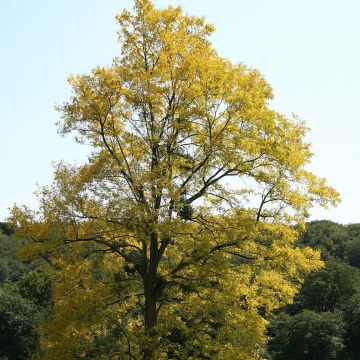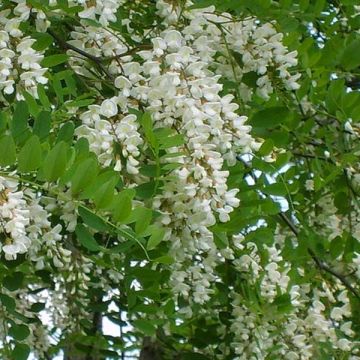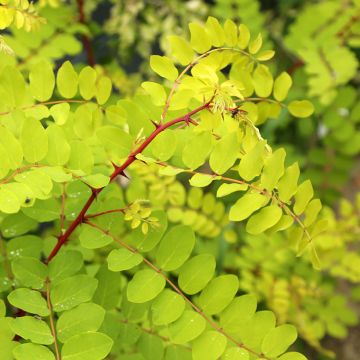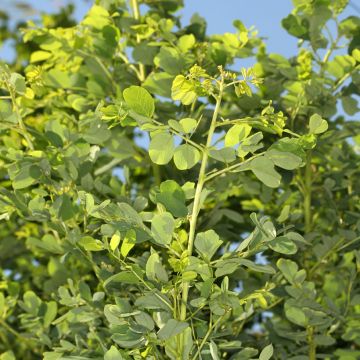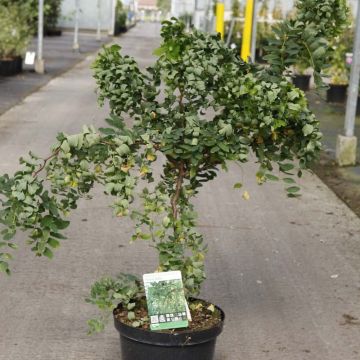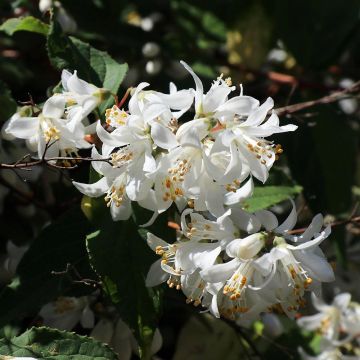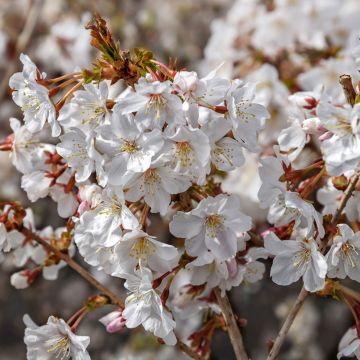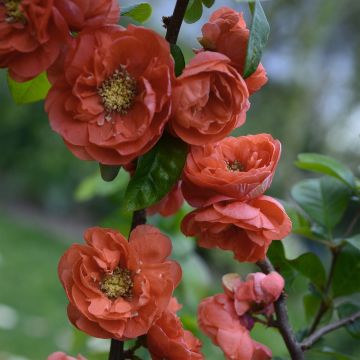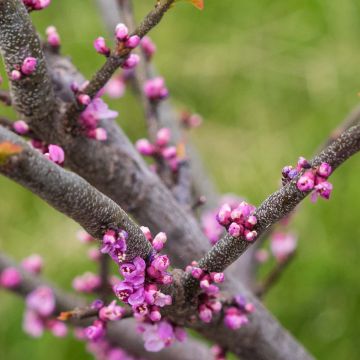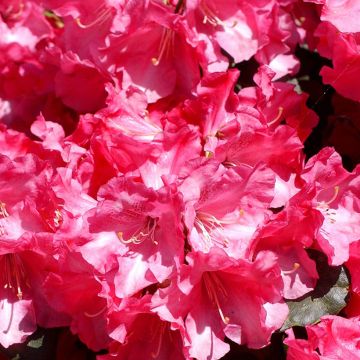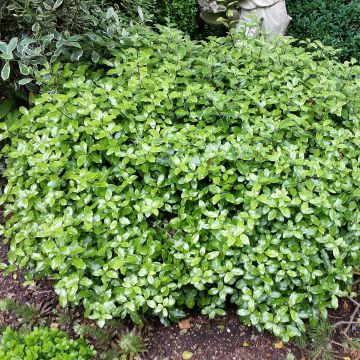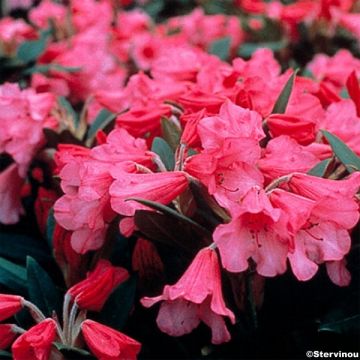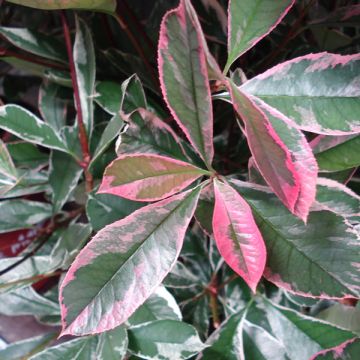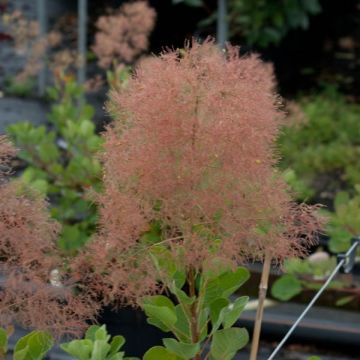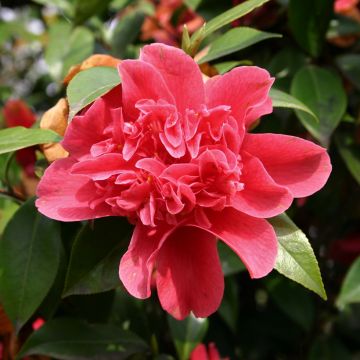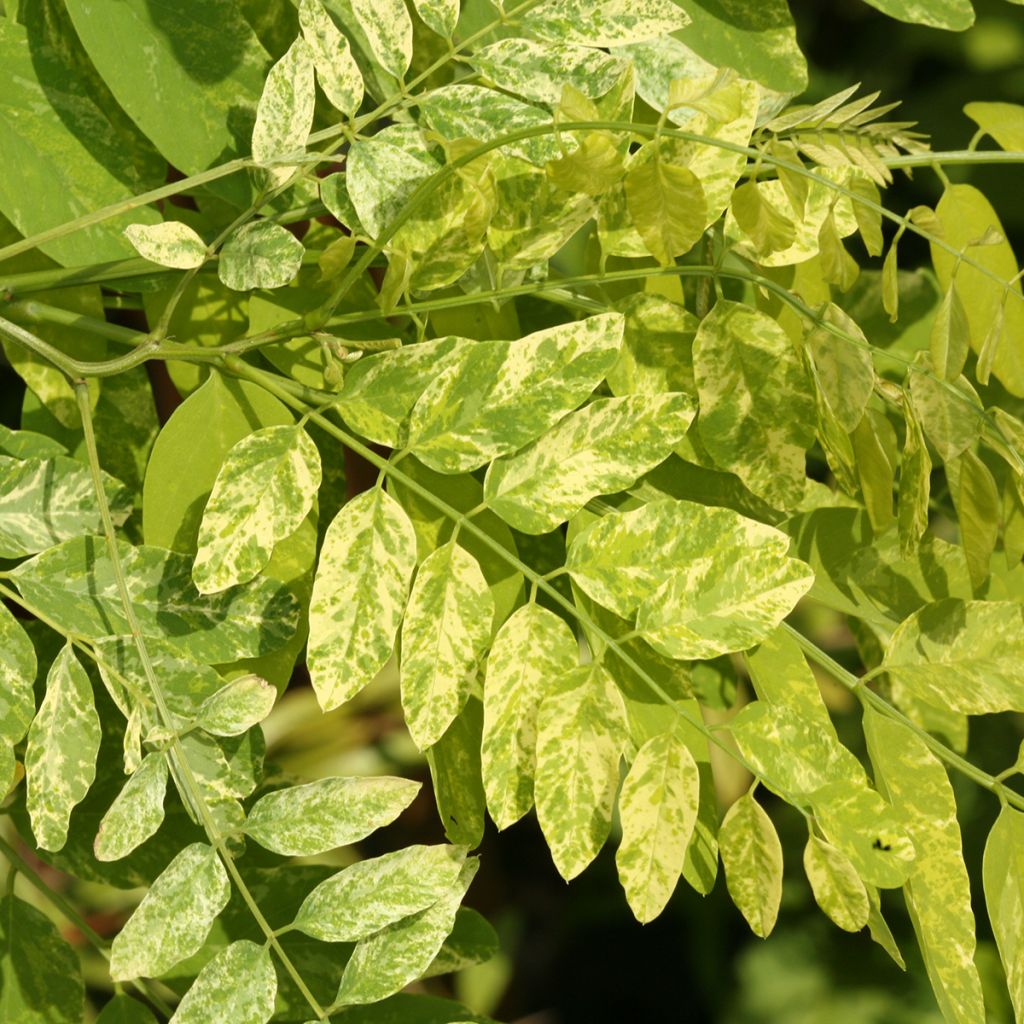

Robinia pseudoacacia Karolina Zamoyska
Robinia pseudoacacia Karolina Zamoyska
Robinia pseudoacacia Karolina Zamoyska
Black Locust, False Acacia
Why not try an alternative variety in stock?
View all →This plant carries a 24 months recovery warranty
More information
We guarantee the quality of our plants for a full growing cycle, and will replace at our expense any plant that fails to recover under normal climatic and planting conditions.
Oversize package: home delivery by special carrier from €6.90 per order..
Express home delivery from €8.90.
Does this plant fit my garden?
Set up your Plantfit profile →
Description
Robinia pseudoacacia Karolina Zamoyska is a variety of false acacia with variegated foliage, marbled with yellow or light green at first. The variegation then lightens to become white over time. This robinia has an astonishing and moving history, it is a rare and precious tree. An old Polish variety from the Podzamcze nurseries in the early 20th century, it then disappeared without a trace, until, in 1981, a variegated specimen was discovered near Warsaw and identified as the Karolina Zamoyska variety. It appreciates a slightly shaded position where its leaves express their variegation better. This beautiful deciduous tree has a flexible and airy habit and fine foliage that provides light shade without harming companion plants. It grows in any soil and in almost all climates, except in windy regions, as its wood is brittle.
Robinia Karolina Zamoyska is a horticultural creation derived from Robinia pseudoacacia, a tree native to the eastern United States of the fabaceae family. In this family, plants are capable of assimilating atmospheric nitrogen at their roots and therefore do not need to draw it from the soil, this characteristic allows them to grow in poor environments. Karolina Zamoyska, cultivated in the famous Podzamcze nurseries, was part of the nursery's offer between 1903 and 1913. The variety was named in honour of Karolina Franciszka Józefa Zamoyska. After World War II, the tree disappeared without a trace. It was only in 1981 that Wiesław Gawryś, from the Powsin botanical garden, found a tree with atypical cream variegated leaves in a park near the Hoser nurseries in Pruszków, near Warsaw. After observation and comparison with available archival documents, the tree was identified as Karolina Zamoyska. The tree was reproduced in 2006 and reintroduced into cultivation.
Karolina Zamoyska is smaller than the species with bright and changing foliage. It is a long-lived tree with a columnar habit during the first years, whose sparse canopy becomes rounded over time. It is fast-growing and reaches an average height of 8 m with a spread of 4-5 m. The bark is initially smooth then takes on an interestingly fissured texture with age. The branches are composed of strong but brittle branches with a few thorns. Its deciduous, 15 to 20 cm long leaves are divided into about twenty leaflets. They are highly decorative, initially variegated with yellow and light green before maturing to dark green and white. Flowering takes place in May, on individuals about ten years old. The pendulous, 10 to 20 cm long inflorescences are produced abundantly. They are composed of white butterfly-like flowers. This highly fragrant flowering, with an orange scent, attracts pollinating insects and can be cooked in fritters. It is followed by the formation of flat, reddish pods containing a few rare brown bean-shaped seeds. Please note, only the flowers can be consumed, the rest of the plant is highly toxic.
Robinia Karolina Zamoyska is suitable for small and large gardens, but it is not recommended in windy situations. Planted individually in a small garden, it also thrives on slopes or in informal hedges in a large garden. You can place it against a backdrop of evergreen shrubs or conifers (cypress, thuja, yew, juniper). In poor soil, it can also be associated with other undemanding and highly ornamental trees or shrubs such as Sophora davidii, laburnum, Indigofera gerardiana, a red oak (Quercus robur Purpurascens) or a purple hazelnut. Welcome it into your garden for its beautiful variegated foliage and its history.
Report an error about the product description
Plant habit
Flowering
Foliage
Botanical data
Robinia
pseudoacacia
Karolina Zamoyska
Papilionaceae
Black Locust, False Acacia
Cultivar or hybrid
Other Robinia - Black Locust
Planting and care
Robinia pseudoacacia is easy to grow in all regions. It thrives sheltered from strong winds and sea spray, as its branches are brittle and the wind can damage its flowering. The soil should be light and well-drained, even poor, preferably moist, although this variety tolerates summer drought once established. It dislikes excess limestone and clay, which can suffocate the roots. Its resistance to atmospheric pollution is excellent, making it valuable in urban areas. Prune dead or weak wood from August to October, to prevent sap flow, and remove branches that cross within the canopy to maintain the proper shape of the Robinia. Beware of voles that love bark and attack the base of plants.
Preferably plant this variety in partial shade.
Planting period
Intended location
Care
This item has not been reviewed yet - be the first to leave a review about it.
Spring-flowering shrubs
Haven't found what you were looking for?
Hardiness is the lowest winter temperature a plant can endure without suffering serious damage or even dying. However, hardiness is affected by location (a sheltered area, such as a patio), protection (winter cover) and soil type (hardiness is improved by well-drained soil).

Photo Sharing Terms & Conditions
In order to encourage gardeners to interact and share their experiences, Promesse de fleurs offers various media enabling content to be uploaded onto its Site - in particular via the ‘Photo sharing’ module.
The User agrees to refrain from:
- Posting any content that is illegal, prejudicial, insulting, racist, inciteful to hatred, revisionist, contrary to public decency, that infringes on privacy or on the privacy rights of third parties, in particular the publicity rights of persons and goods, intellectual property rights, or the right to privacy.
- Submitting content on behalf of a third party;
- Impersonate the identity of a third party and/or publish any personal information about a third party;
In general, the User undertakes to refrain from any unethical behaviour.
All Content (in particular text, comments, files, images, photos, videos, creative works, etc.), which may be subject to property or intellectual property rights, image or other private rights, shall remain the property of the User, subject to the limited rights granted by the terms of the licence granted by Promesse de fleurs as stated below. Users are at liberty to publish or not to publish such Content on the Site, notably via the ‘Photo Sharing’ facility, and accept that this Content shall be made public and freely accessible, notably on the Internet.
Users further acknowledge, undertake to have ,and guarantee that they hold all necessary rights and permissions to publish such material on the Site, in particular with regard to the legislation in force pertaining to any privacy, property, intellectual property, image, or contractual rights, or rights of any other nature. By publishing such Content on the Site, Users acknowledge accepting full liability as publishers of the Content within the meaning of the law, and grant Promesse de fleurs, free of charge, an inclusive, worldwide licence for the said Content for the entire duration of its publication, including all reproduction, representation, up/downloading, displaying, performing, transmission, and storage rights.
Users also grant permission for their name to be linked to the Content and accept that this link may not always be made available.
By engaging in posting material, Users consent to their Content becoming automatically accessible on the Internet, in particular on other sites and/or blogs and/or web pages of the Promesse de fleurs site, including in particular social pages and the Promesse de fleurs catalogue.
Users may secure the removal of entrusted content free of charge by issuing a simple request via our contact form.
The flowering period indicated on our website applies to countries and regions located in USDA zone 8 (France, the United Kingdom, Ireland, the Netherlands, etc.)
It will vary according to where you live:
- In zones 9 to 10 (Italy, Spain, Greece, etc.), flowering will occur about 2 to 4 weeks earlier.
- In zones 6 to 7 (Germany, Poland, Slovenia, and lower mountainous regions), flowering will be delayed by 2 to 3 weeks.
- In zone 5 (Central Europe, Scandinavia), blooming will be delayed by 3 to 5 weeks.
In temperate climates, pruning of spring-flowering shrubs (forsythia, spireas, etc.) should be done just after flowering.
Pruning of summer-flowering shrubs (Indian Lilac, Perovskia, etc.) can be done in winter or spring.
In cold regions as well as with frost-sensitive plants, avoid pruning too early when severe frosts may still occur.
The planting period indicated on our website applies to countries and regions located in USDA zone 8 (France, United Kingdom, Ireland, Netherlands).
It will vary according to where you live:
- In Mediterranean zones (Marseille, Madrid, Milan, etc.), autumn and winter are the best planting periods.
- In continental zones (Strasbourg, Munich, Vienna, etc.), delay planting by 2 to 3 weeks in spring and bring it forward by 2 to 4 weeks in autumn.
- In mountainous regions (the Alps, Pyrenees, Carpathians, etc.), it is best to plant in late spring (May-June) or late summer (August-September).
The harvesting period indicated on our website applies to countries and regions in USDA zone 8 (France, England, Ireland, the Netherlands).
In colder areas (Scandinavia, Poland, Austria...) fruit and vegetable harvests are likely to be delayed by 3-4 weeks.
In warmer areas (Italy, Spain, Greece, etc.), harvesting will probably take place earlier, depending on weather conditions.
The sowing periods indicated on our website apply to countries and regions within USDA Zone 8 (France, UK, Ireland, Netherlands).
In colder areas (Scandinavia, Poland, Austria...), delay any outdoor sowing by 3-4 weeks, or sow under glass.
In warmer climes (Italy, Spain, Greece, etc.), bring outdoor sowing forward by a few weeks.

































